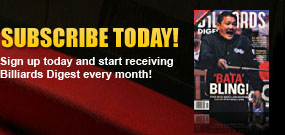 Tips & shafts By George Fels Consulting Editor George Fels has been writing for Billiards Digest since 1980, and his "Tips & Shafts" column is usually our readers' first stop when they crack open the magazine. For better or worse, pool has been his only mistress for 40-plus years.
Archives
Best of Fels
|
|
August: Fist Bridge August 2011 PUT A fist bridge down on the pool table the other day. It would be nice to report that a genie popped out of my cue tip and granted me three wishes (even dirty ones), but the antique nuance somehow did take me to a bunch of places at once.
For one, it occurred to me that you practically have to be of my well-preserved vintage before you even understand what this particular tool is. Its origin was almost certainly in straight-rail and balkline billiards, two games long extinct in this country. And its only real ongoing applications would be the exclusive province of 14.1 (gamely battling obsolescence itself) and one-pocket, because you only want this bridge when the cue ball and object ball (and, usually, the cluster) are in extremely close quarters. Draw is your only real option; this bridge lets you get as low as an open thumb would but with more control, and you have less of a "hand-print" to pull back out of the way.
The bridge is what it sounds like: just put your knuckles down on the table and put your cue shaft where it always goes, over your thumb and firmly betwixt index and social fingers. If you believe in the concept of "feeling" the cue ball, which wouldn't be a bad idea at all, the fist bridge brings your entire hand closer to the actual cue tip/cue ball contact. And no bridge permits you to "nip-draw" the cue ball more efficiently.
So if you rarely see this odd basic any more, what other relics from its era are vanishing too? Well, of course it was the era of the spittoon, but I'm not going to waste (how appropriate) any nostalgia on that. There was the rack apron, just a layer of fairly heavy cloth that was either sewn or snapped onto any side of the rack, designed to minimize wear on the cloth near the foot rail where the balls were repeatedly dropped for re-racking. The one I still have at home is falling apart but I just can't bring myself to perform the coup de grace; it reads "Marvel Billiard and Bowling Supply" (that sequence alone suggests a bygone era), and offers a phone number so old that it begins with a word instead of digits. I've bounced so many object balls on its unlucky little face; the least I can do is let it live out its days and then some.
Accordingly, the era of the fist bridge would also have been the period in which most commercial rooms did far more for their patrons than merely issue the balls and accept the cash. For one thing, they employed the equivalent of pinsetters to do the racking for you. The same personnel, usually titled "table porters" or, far more rarely, "table maids," knew all the regulars by name, fetched their personal cues while checking their coats in the same room, and hoped to be tipped for it. They weren't always.
There was the first room in which I ever saw a fist bridge myself, Chicago's great downtown Bensinger's of course, and the player who used it. I was 15, had never seen one-pocket played anyplace, and the notion of grown men doing their Sunday best to not pocket balls was certainly exotic to me. But old Angus MacDonald, one of the true "great unknowns" of whom I've often written, still seemed to me to be playing a game unlike that played by anyone else in the room. And that fist bridge was just one more personal brush in his private palette.
There was also the mysterious matter of how furious the fist bridge made my best pool buddy/Best-Buddy-Ever, the late Jack Gunne. This defies any explanation, except to point out that it was not his only irrationality, cue games-oriented or otherwise. His point on the fist bridge, if you could call it one, was that it reminded him of "the crippled kids I useta see beggin' on Times Square. 'Hey, mister, any change?' For God's sakes, put a goddamn man's bridge on th' bleeper-bleepin' table!" When our interest turned to three-cushion, he seemed to feel there was something sissified about the little rail-first "tickey" billiards that score their point in a few inches instead of feet. He had no particular reason for that one, which was good, since it makes just about as much sense as going ballistic over seeing a fist bridge. And neither of those ignited him as effectively as the much-ballyhooed innocence (or, as he obsessed, guilt) of boxing cause celebre Rubin "Hurricane" Carter. Just one look at a fist bridge could send him to an advanced state of looniness on any of the three topics, though. I suppose I might as well admit I used that tactic on him more than once in tight games. He usually couldn't drop a grape in the Grand Canyon thereafter.
The room in which all this hoo-hah over a peculiar bridge took place was called The Golden 8-Ball; it had a life of almost exactly 10 years. Its 4-by-8-foot gold-cloth tables were aptly named for the late Harold Worst. Its original house cues were all two-piece, also bearing Worst's name, which took a hike in the room's first few weeks. Its pockets were so permissive that an object ball frozen to a long rail near a side pocket could actually be sunk there if you just rolled it up softly enough. But it did offer us the exquisite indulgence of pool at lunch. Just about all the tables around us hosted other advertising writers and especially art directors, plus editorial staffers from nearby Playboy. To a man, they swore that they would leave their offices with problems unsolved, and within 60 or 90 minutes of the magical game, they were ready to get back to work with shiny new ideas abundant.
Sorry, Jack, but I needed that fist bridge the other day. Made the ball, too.
|





